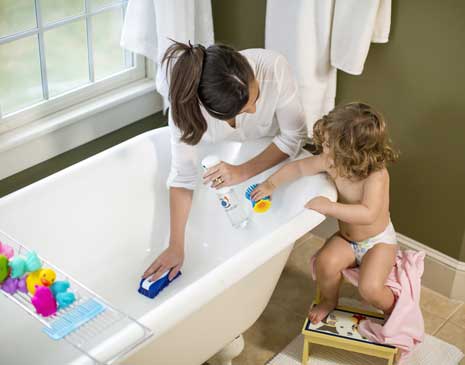
Cabinet safety locks are one of the first things the parent of a newly walking toddler reaches for. Those and the ever-critical toilet safety locks! As you know, there is good reason to keep that cabinet full of cleaning hazmats under the kitchen sink locked up. Cleaning products are FULL of dangerous toxic chemicals, and we don’t just mean bleach and ammonia. You might be surprised to learn how much manufacturers are allowed to hide about the dangers their products pose. Even so-called “natural” cleaners are not the safe, chemical free cleaning products you think they are. Here are the top myths parents should know about the safety of the cleaning products in their homes:
Myth: Regulations ensure that the chemicals you use in your home are safe. Fact: Out of some 62,000 chemicals approved for use in the US, only about 300 have actually been tested for safety.
Myth: Ingredient lists have to disclose what’s in the product. Fact: Cleaning product manufacturers aren’t required to show their full ingredient lists on their labels.
Myth: If a product is labelled as “natural”, it is safer. Fact: There are no federal standards dictating criteria for what cleaning products can be labeled as “natural”. Even “natural” cleaning products frequently contain toxic chemicals that are linked to hormone disruption, organ and neurotoxicity, respiratory & skin irritants and allergens.
These facts make it very hard to ensure the cleaning products you’re buying are safe, but that’s why we’re here to help with the top 6 chemicals to avoid. We’re skipping over ammonia and bleach (sodium hypochlorite) since you probably already know to steer clear of those.
Chemical Free Cleaning Products: The Top 5 Ingredients to Avoid
1. Fragrances: Manufacturers have tried to train us that clean has a smell. Maybe that smell is lavender, lemon, pink grapefruit, white grapefruit or any other color of innocent sounding fruit, but trust us, you should avoid it. Fragrances don’t add anything to the efficacy of a cleaning product, and instead introduce potentially significant health risks. The fact is that fragrances are not nearly as safe as most parents think they are, which is why they earn the #1 spot on our ingredients to avoid. Here is why:
- Fragrance chemicals can pass through the skin and enter the blood stream. They are classified as carcinogens, hormone disruptors, neurotoxins, skin and respiratory irritants.
- The fragrance industry is self-regulated. Safety testing does not have to precede product sales, and fragrance cocktails don’t require reviews by regulatory agencies.
- Fragrances are considered trade secrets, so that manufacturers aren’t required to disclose the potentially hundreds of ingredients hiding behind the one word “fragrance”.
Don’t buy a cleaning product if you see the words “fragrance” on the label. That means step away from the air fresheners too! They just attempt to pollute away odors with toxic chemicals. And don’t be tricked by the phrase “fragrance-free” or “unscented”. You also have to check the ingredient list, because sometimes companies use a masking fragrance to cover the chemical smell of their product. Also watch out for products labeled as “natural” or “natural fragrance,” because there is no standard criteria for what these words mean.
2. Phthalates: Studies have shown that more than 75% of products with fragrances contain these nasty endocrine disruptors, but you won’t find them listed on labels. One glance at the health risks of phthalates will probably cause you to go fragrance-free right away. The Centers for Disease Control reported that phthalates can be found in the blood of most Americans, and the greatest quantities are in women.
3. Ethanolamine compounds (DEA, MEA, TEA): These toxic chemicals are commonly used emulsifiers, fragrance additives & pH adjusters. They are associated with hormone disruption, cancer and organ toxicity.
4. Methylsothiazolinone (MIT) & Methylchloroisothiazolinone (CMIT): These preservatives are extremely common in cleaning products labeled as “natural” even though they are linked with inhalation toxicity, dangerous allergic reactions and possible neuro toxicity. Again because cleaning product manufacturers aren’t required to list all their ingredients, it’s hard to know what products they are in. Our advice is to look for cleaning products that say they are preservative-free or MIT free or CMIT free.
5. Quaternary ammonium compounds (QUATs): QUATs are very common in cleaners labeled as disinfectants, and they are associated with allergies, asthma, fertility issues & birth defects. They may not be listed on ingredient labels at all, or if they are, they could be listed under multiple different names. For a list of those check here, or instead stick toxic chemical free cleaning products that contain only safe ingredients.
Learn More
Given that “natural” cleaners can still be chock full of toxic chemicals and that ingredient labels are often incomplete, it’s a tough challenge to find toxic chemical free cleaning products. A great resource for researching chemical safety is EWG. But our best advice is to go fragrance & preservative free, and choose products with safe, simple ingredients. A great option is Force of Nature, a small appliance that uses electricity to turn salt, water & vinegar into a non toxic cleaner and deodorizer just as effective as bleach. It has no fragrances, preservatives, dyes, allergens or irritants. It’s so safe your kids can help you clean (yay!) and there’s no need to rinse or even wear gloves. To learn more, hop on over here.



